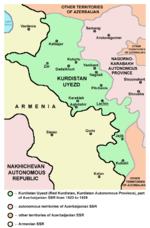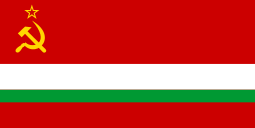List of Iranian dynasties and countries
The following is an incomplete list of historical dynasties which were at some time Iranian or the country they ruled were Iranian-speaking and of modern countries with significant Iranian populations or with an official Iranian language. The Iranians comprise the Persians, Medes, Scythians, Kurds, Bactrians, Pashtuns, Tajiks, Baloch, Parthians, Sarmatians, Alans, Ossetians, Cimerians, and much more.
Current states
Independent states
Federal subjects of Russia
Autonomous regions
Historical confederation of tribes and Iranian dynasties
- Scythians
- Cimmerians
- Kidarites
- Xionites
- Dahae
- Sarmatians
- Saka
- Sogdiana
- The Pahlavas
- Massagetaeans
- Roxolani
- Siraces
- Iazyges
- Bulgars (usually considered Turkic but possibly containing Iranian elements)[1][2]
Europe
Direct Iranian dynasties
- Medes (ca. 678 BCE–549 BCE) of Median origin
- Achaemenid Empire (550–330 BC) of Persian origin
- Atropatene (320s BC–3rd century AD) of Persian origin
- Parthian Empire (247 BC–224 AD) of Parthian origin
- Indo-Scythians (200 BCE–400 AD) of Scythian origin
- Indo-Parthian Kingdom (12 BC–before 100 AD?) Of Parthian origin
- Sasanian Empire (224–651) of Persian origin
- Afrighids (305–995) of Khwarezmian origin
- Dabuyid dynasty (642–760) Of Persian and Tabari origin
- Masmughans of Damavand (650–760) Of Parthian origin
- Bavand dynasty (651–1349) Of Parthian origin
- Paduspanids (665-1598) of Persian and Tabari origin
- Qarinvand dynasty (7th-century–11th-century) of Parthian origin
- Justanids (791-974) of Dailamite origin
- Shirvanshah (1207-1607) originally of Arab origin, but speedily Persianized[3][4] within their culturally Persian environment.[4]
- Samanids (819–999) of Persian origin
- Tahirid dynasty (821–873) of Persian origin
- Banijurids (848-908) of Persian origin
- Saffarid dynasty (861–1003) of Persian origin
- Sajid dynasty (889/890–929) of Sogdian origin
- Farighunids (10th century-1010) of Persian origin
- Sallarid dynasty (919–1062) of Dailamite origin
- Ziyarid dynasty (931–1090) of Dailamite origin
- Banu Ilyas (932–968) of Sogdian origin
- Buyid dynasty (934–1055) of Dailamite origin
- Shaddadids (951–1174) of Kurdish origin
- Ma'munids (995–1017) of Khwarezmian origin
- Kakuyids (1008–1141) of Dailamite origin
- Ghurid Dynasty (1011–1215) of Tajik origin
- Nasrid dynasty (Sistan) (1029–1225) of Persian origin
- Atabegs of Yazd (1141–1319) of Persian origin
- Ayyubid dynasty (1171–1341) of Kurdish origin
- Mihrabanids (1236–1537) of Persian origin
- Kurt Dynasty (1244-1381) Of Tajik origin
- Afrasiab dynasty (1349-1504) of Iranian
- Safavid dynasty (1501–1736) of Kurdish and Turkic origin
- Zand dynasty (1750–1794) of Luri origin
- Afsharid dynasty (1736–1796) Iranian dynasty of Turkic origin
- Hotaki dynasty (1709–1738) of Pashtun origin
- Talysh Khanate (1747–1826) of Persian origin
- Durrani Empire (1747–1862) of Pashtun origin
- Barakzai dynasty (1826-1973) of Pashtun origin
- Pahlavi dynasty (1925-1979) of Persian origin
Persianate or Turko-Persian states
Main articles: Persianate society and Turko-Persian tradition
Some Turko-Persian states were founded in Greater Iran.[5]
- Ghaznavid Empire (962–1187) (ruled by a thoroughly Persianized family of Turkic mamluk origin)[6][7]
- Great Seljuk Empire (1073–1307) (ruled by a predominantly Persian-speaking clan[8] of originally Oghuz Turkic descent. The majority of the population was Iranian.[6][9][10][11])
- Seljuk Sultanate of Rûm (1077–1307) (A Turko-Persian dynasty of Oghuz Turkic descent.)[12]
- Khwarezmian Empire (ruled by a family of Turkic mamluk origin.)[13]
- Timurid dynasty (1370–1506) (Persianized dynasty of Turko-Mongol origin)
- Mamluk dynasty (1206–90; Persian-speaking)
- Khilji dynasty (1290-1320; Persian-speaking, Turko-Afghan)
- Tughlaq dynasty (1320–1413; Persian-speaking)
- Qutb Shahi dynasty (1518-1687; Persian-speaking)
- Mughal Empire (Built and ruled by the Baburid dynasty of Turkicized Mongol origin, with the adoption of aspects of Persian culture and language).[14][15][16][17][18]
- Ottoman dynasty (1299-1922) (A Persianate Turkish dynasty which ruled the Ottoman Empire)[11][19][20]
- Qajar dynasty (1785–1925) (A Persianized Iranian dynasty[21] of originally Turkic Oghuz descent[22] which ruled Persia).
Former and defunct Iranian governments
 Khanate of Kalat (1666-1955)
Khanate of Kalat (1666-1955) Soviet Republic of Gilan (1920-1921)
Soviet Republic of Gilan (1920-1921) Autonomous Government of Khorasan (1921)
Autonomous Government of Khorasan (1921).svg.png) Kingdom of Kurdistan (1921-1924)
Kingdom of Kurdistan (1921-1924) Kurdistansky Uyezd (1923-1929)
Kurdistansky Uyezd (1923-1929).png) Republic of Ararat (1927–1930)
Republic of Ararat (1927–1930) Tajik Soviet Socialist Republic (1929-1991)
Tajik Soviet Socialist Republic (1929-1991) North Ossetian Autonomous Soviet Socialist Republic (1936-1992)
North Ossetian Autonomous Soviet Socialist Republic (1936-1992) Republic of Mahabad (1946-1947)
Republic of Mahabad (1946-1947) Talysh-Mughan Autonomous Republic (1993)
Talysh-Mughan Autonomous Republic (1993)
See also
- Iranian peoples
- Iranian languages
- Nomadic empire
- Pan-Iranian colors
- List of Kurdish dynasties and countries
Notes
- ↑ Brook, Kevin Alan (27 September 2006). The Jews of Khazaria. Rowman & Littlefield Publishers. p. 13. ISBN 1442203021. Retrieved 3 June 2015.
Thus, the Bulgars were actually a tribal confederation of multiple Hunnic, Turkic, and Iranian groups mixed together.
- ↑ "Bulgar". Encyclopædia Britannica Online. Encyclopædia Britannica, Inc. Retrieved 3 June 2015.
Although many scholars, including linguists, had posited that the Bulgars were derived from a Turkic tribe of Central Asia (perhaps with Iranian elements)
- ↑ Barthold, W., C.E. Bosworth "Shirwan Shah, Sharwan Shah. "Encyclopaedia of Islam. Edited by: P. Bearman, Th. Bianquis, C.E. Bosworth, E. van Donzel and W.P. Heinrichs. Brill, 2nd edition
- 1 2 C.E. Bosworth, "ŠERVĀNŠAHS" in Encyclopaedia Iranica. Excerpt 1: "ŠERVĀNŠAHS (Šarvānšāhs), the various lines of rulers, originally Arab in ethnos but speedily Persianized" Excerpt 2:" ). Just as an originally Arab family like the Rawwādids in Azerbaijan became Kurdicized from their Kurdish milieu, so the Šervānšāhs clearly became gradually Persianized, probably helped by intermarriage with the local families of eastern Transcaucasia; from the time of Manučehr b. Yazid (r. 418-25/1028-34), their names became almost entirely Persian rather than Arabic, with favored names from the heroic national Iranian past and with claims made to descent from such figures as Bahrām Gur".
- ↑ Lewis, Bernard. "Istanbul and the Civilization of the Ottoman Empire", p29. Published 1963, University of Oklahoma Press. ISBN 0-8061-1060-0.
- 1 2 M.A. Amir-Moezzi, "Shahrbanu", Encyclopaedia Iranica, Online Edition, (LINK): "... here one might bear in mind that non-Persian dynasties such as the Ghaznavids, Saljuqs and Ilkhanids were rapidly to adopt the Persian language and have their origins traced back to the ancient kings of Persia rather than to Turkish heroes or Muslim saints ..."
- ↑ Muhammad Qāsim Hindū Šāh Astarābādī Firištah, "History Of The Mohamedan Power In India", Chapter I, "Sultān Mahmūd-e Ghaznavī", p.27: "... "Sabuktegin, the son of Jūkān, the son of Kuzil-Hukum, the son of Kuzil-Arslan, the son of Fīrūz, the son of Yezdijird, king of Persia. ..."
- ↑ Jonathan Dewald, "Europe 1450 to 1789: Encyclopedia of the Early Modern World", Charles Scribner's Sons, 2004, p. 24
- ↑ K.A. Luther, "Alp Arslān" in Encyclopaedia Iranica, Online Edition, (LINK): "... Saljuq activity must always be viewed both in terms of the wishes of the sultan and his Khorasanian, Sunni advisors, especially Nezām-al-molk ..."
- ↑ Encyclopaedia Britannica, "Seljuq", Online Edition, (LINK): "... Because the Turkish Seljuqs had no Islamic tradition or strong literary heritage of their own, they adopted the cultural language of their Persian instructors in Islam. Literary Persian thus spread to the whole of Iran, and the Arabic language disappeared in that country except in works of religious scholarship ..."
- 1 2 O.Özgündenli, "Persian Manuscripts in Ottoman and Modern Turkish Libraries", Encyclopaedia Iranica, Online Edition, (LINK)
- ↑ Bernard Lewis, Istanbul and the Civilization of the Ottoman Empire, 29; "Even when the land of Rum became politically independent, it remained a colonial extension of Turco-Persian culture which had its centers in Iran and Central Asia","The literature of Seljuk Anatolia was almost entirely in Persian...".
- ↑ M. Ismail Marcinkowski, Persian Historiography and Geography: Bertold Spuler on Major Works Produced in Iran, the Caucasus, Central Asia, India and Early Ottoman Turkey, with a foreword by Professor Clifford Edmund Bosworth, member of the British Academy, Singapore: Pustaka Nasional, 2003, ISBN 9971-77-488-7.
- ↑ Thackston 1996
- ↑ Findley 2005
- ↑ Saunders 1970, p.177
- ↑ "The Islamic World to 1600: The Mongol Invasions (The Tamarind Empire)". Ucalgary.ca. Retrieved 2011-07-06.
- ↑ "The Islamic World to 1600: Rise of the Great Islamic Empires (The Mughal Empire)". Ucalgary.ca. Retrieved 2011-07-06.
- ↑ Yarshater, Ehsan. 1988. The development of Iranian literatures. In Persian Literature, ed. Ehsan Yarshater, pp. 3—37. (Columbia Lectures on Iranian Studies, no. 3.) Albany: Bibliotheca Persica and State University of New York, 15
- ↑ "Persian in service of the state: the role of Persophone historical writing in the development of an Ottoman imperial aesthetic", Studies on Persianate Societies 2, 2004, pp 145-163.
- ↑ Abbas Amanat, The Pivot of the Universe: Nasir Al-Din Shah Qajar and the Iranian Monarchy, 1831–1896, I.B.Tauris, pp 2–3
- ↑ Richard N. Frye and Lewis V. Thomas. The United States and Turkey and Iran, Harvard University Press, 1951, p. 217
This article is issued from Wikipedia - version of the 11/13/2016. The text is available under the Creative Commons Attribution/Share Alike but additional terms may apply for the media files.